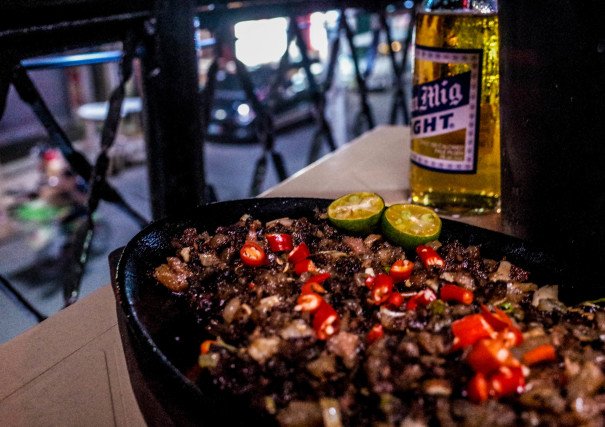
Chopped Pig Head, a Substantial Abdominal Coating for All‑Night Benders

Chopped Pig Head, a Substantial Abdominal Coating for All‑Night Benders
Sisig in Manila
Drinking on an empty stomach is a bad idea. Everyone knows that. The less in there, the faster you feel the effects of alcohol. What to eat before a big night out? People have various theories, from eggs, avocados, and sardines on toast to lard-laden burgers. The common factor is the necessary fat content.
You need that lining of oil in your stomach before a full night of debauchery.
On this side of the world, the Philippines presents the ultimate drinking match: sisig.
Our regular haunt is in one of the seedier parts of old Manila. The humid, open-aired shack overlooks the busy street of Remedios. Before the night’s festivities, you can watch street vendors prepare for work and listen to a band’s sound check next door. Girls clad in extremely short school uniforms practice funny-sounding Filipino-Japanese cheers below.
You must order the Bucket Promo for a few pesos: six bottles of beer in a plastic or metal bucket filled with ice and your choice of pulutan (food eaten with alcohol), the sisig.
Our bucket was bedecked with the logo of a famous local motel.
Don’t get any ideas.
The head of a pig is chopped finely, sautéed with onions, chillies, and served on a sizzling plate. The bits and pieces of pork ears and jowl are charred to a black-and-brown crisp. It is meaty, tangy, and greasy. The bright red chillies and local green lemons add the needed kick. The sizzling plate brings out the extra oil and provides a substantial abdominal coating for a all-night bender.
The trademark dish has three phases. Boiling, grilling, and sautéing. The entire head of the pig is first boiled to soften and remove the hairy fuzz. It is then chopped in portions for broiling or grilling. Before serving, with two large cleavers it is hacked into unrecognizable parts and incorporated with onions, chillies, soy, vinegar and calamansi (local lemon).
Sisig originated in the province of Pampanga, Central Luzon, north of Manila. The literal translation means “to snack on something sour” like an unripe fruit. The word also refers to the method of marinating meat in a sour liquid, such as vinegar or lemon. In the mid 1970s, local residents bought unused pig heads from the American commissaries at Clark Air Base in Angeles City, Pampanga. The U.S. personnel stationed there did not use the heads in their meals, hence the abundance.
The enterprising restaurateur Lucia Cunanan has been credited with concocting the bizarre dish in 1974 in Angeles City. Eventually, even the U.S. servicemen began to order it with their beers in various night clubs in Pampanga.
Lucia Cunanan’s legacy is the most popular pulutan in the Philippines. Tragically, in 2008 she was found stabbed to death by her husband over a gambling row. Her small railroad shack—Aling Lucing’s in Angeles—still stands today.
Variations have evolved through the years: some add chopped liver or ox brains, and even top it off with a raw egg, pork crackling, and mayonnaise.
The artery-clogging pork massacre is far from refined. It is not for the faint of heart (palpitations included) but possibly the best thing you can have with an iced cold beer.
After a couple buckets down, does it really matter?
Only the next day’s hangover can tell.